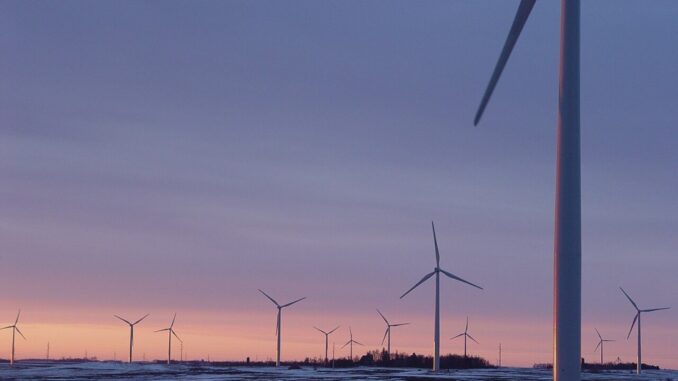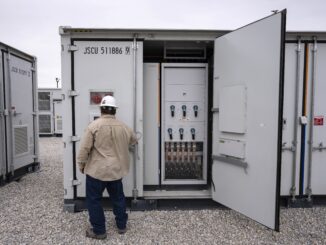
A group of utilities that once went big on building transmission is now going small to open bottlenecks and move more wind power from western Minnesota and the Dakotas.
Grid North Partners, which includes 10 investor- and consumer-owned utilities, will spend roughly $130 million for 19 transmission upgrades to improve access to wind energy and reduce grid congestion.
Many of its members, including Xcel Energy, Minnesota Power and Great River Energy, are also involved in much larger transmission projects through the Midcontinent Independent System Operator, or MISO, which manages the grid in the central portion of the country.
The utility partnership came together in 2004 to begin planning additional transmission lines to tap wind generation in the state’s western regions and the Dakotas. The CapX2020 initiative, as it came to be called, developed the largest transmission project in the Upper Midwest in more than 40 years.
Between 2010 and 2017, CapX2020 spent $2 billion on five projects that created more than 800 miles of new transmission lines. The initiative interconnected 3,600 megawatts of wind energy, enough to power 1.5 million homes annually.
The planning for CapX2020 took place before MISO began extensively planning regional transmission lines. MISO eventually incorporated CapX2020 into a portfolio of projects that decade, a precursor to a current batch of projects announced this year known as “Tranche 1,” two of which involve Great River Energy.
Beth Soholt, executive director of the Clean Grid Alliance, said the Grid North projects serve a different purpose. Rather than add a huge volume of new capacity, the projects will create “a bridge until we get the new large transmission lines in place” and create enough capacity to allow utilities to continue adding solar and wind.
Utilities involved seek to “use the existing grid we have better,” she said. “You’ve got a spectrum of smaller things you could do quickly, that are not going to solve your whole problem, but they’re going to help and they’re going to be quick.”
Unlike bigger projects, which will take years, Grid North Partners said the upgrades will be completed over the next three years and be finished by the end of 2026. The partnership of the state’s major utilities and cooperatives includes Xcel, Great River Energy, Minnesota Power, Otter Tail Power, Dairyland Power Cooperative, Missouri River Energy Services, Rochester Public Utilities, Southern Minnesota Municipal Power Agency, Central Municipal Power Agency and WPPI Energy.
Matthew Ellis, Great River Energy’s manager of transmission strategy and development, said big transmission projects take eight to 10 years to build. The generation and transmission cooperative is involved in six Grid North Partners projects in collaboration with other members.
“The goal of this effort was to identify what can be done incrementally to mitigate congestion within the next two to three years,” he said.
Congestion blocks the transmission of clean energy generation and has caused the growing problem of wind curtailment in western Minnesota. The projects will allow “cost generation, like wind and solar, to have better access to the transmission grid,” he said. “The transmission grid is all interconnected. What these projects directly do is allow better access for clean energy resources.”
Grid North Partners conducted the research to determine the location of transmission bottlenecks. Ellis said the experience is a bit like looking at traffic maps and where congestion occurs at different times and places. Electricity from wind and solar generators slows at sites in different parts of the state, he said.
Fixing one part of the grid to reduce congestion sometimes means just adding to another location. “One of the advantages of Grid North Partners is that, by having different utilities partnering up, we can mitigate those downstream impacts,” Ellis said. “We can get a lot more bang for our buck and much more synergy.”
Ellis said the transmission upgrades mainly focus on replacing old equipment, not on adding lines or new transmission towers. Instead, newer technology allowing them to operate more efficiently will be installed. Grid North Partners said in a news release the project will pay for itself.
Upfront costs will be paid for by the utilities that will benefit from them. In some projects, several utilities will split costs; in others, the line and work will be owned by one of the partners, Ellis said. The transmission lines affected by the projects span in length from half a mile to 67 miles.
Xcel Energy said in a statement that congestion in western Minnesota caused by wind projects has pushed the existing grid beyond what it can support and forced the utility to use peaking plants to supplement the energy supply at peak demand times. Congestion “limits our efforts to keep costs low for customers,” Xcel said.
Xcel will partner or be the sole sponsor on 10 Grid North projects, more than any other utility. Two of the largest Xcel projects add second circuits to the existing CapX2020 transmission lines between eastern South Dakota and Lyon County, Minnesota, and between Scott and Dakota counties. After regulatory approval, the western line will be completed by 2024, with the Scott-Dakota project slated for 2025. Xcel has partners on both projects.
“We estimate hundreds of millions of dollars in benefits to customers following the completion of the project due to reduced congestion costs and increased ability to access renewable energy in the region,” Xcel said.
Otter Tail Power’s seven Grid North projects involve upgrading substations, adding circuits and replacing electricity poles, said communications director Stephanie Hoff. No new facilities will be added by the utility.
Hoff said Otter Tail has partnered with other regional utilities on two projects in the long-range MISO plan. Although the Grid North Partners initiative does not directly impact Otter Tail’s generation assets, including renewables, the investment will help the grid function more effectively, she said.
“New and upgraded transmission helps move electricity from where it’s generated to where it’s used,” Hoff said. “When the transmission system can’t move electricity from the most economic energy generators, market prices rise and energy generators may need to be curtailed, resulting in higher electricity costs for customers.”
Grid North Partners’ budget is tiny compared to projects announced by MISO and Xcel. MISO will spend $10.3 billion on its first tranche of transmission projects, with more than $2 billion dedicated to corridors entirely or partially in Minnesota. Xcel Minnesota Energy Connection, linking wind farms in the southwest to a plant in Becker, will cost $1 billion.



